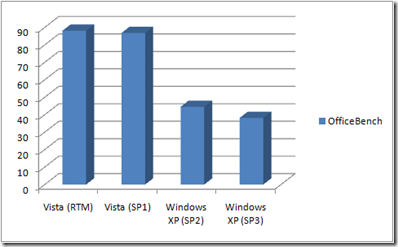Ouch. This hurts. Devil Mountain Software, the outfit that had previously declared Vista SP1 a Performance Dud came to the conclusion that Windows XP SP3 Yields Performance Gains – about 10% compared to XP SP2. That’s the good news. The bad news is that the very same tests show the outgoing operating system, XP twice as fast as Vista, the “flagship” OS. No wonder Forrester Research says Vista’s biggest problem is XP. 

Of course most users won’t notice it. Why? Because very few upgrade their existing computers from XP to Vista. We don’t buy operating systems, we buy computers: try to get one without Vista. (Fact: most of Microsoft’s Vista Revenue comes from the OEM channel.)
The Vista-based new screamer clearly runs a lot faster than the 3-year-old laptop running XP, but in reality it’s running at half-speed – the other half eaten by the Operating System. Which proves my earlier argument abut this being a pointless arms race: buying faster and faster machines only so they can maintain themselves and barely let us use basic applications.
Unless those applications are in the cloud. 
Related posts: PC World, Hardware 2.0 and TECH.BLORGE.com
Update (12/14): Coding Sanity has found a solution.

 OK, OK, I get it… it’s the
OK, OK, I get it… it’s the 

 Wouldn’t it have been cool if Amazon built an e-book reader so inexpensive they could almost give it away for free, then make money by selling e-books for people to read on it (or selling upscale versions of the reader later)? Instead, they stuffed it so full of technological wizardry that it costs $399.
Wouldn’t it have been cool if Amazon built an e-book reader so inexpensive they could almost give it away for free, then make money by selling e-books for people to read on it (or selling upscale versions of the reader later)? Instead, they stuffed it so full of technological wizardry that it costs $399. “A new spam blocker called
“A new spam blocker called 




 Considering how many things
Considering how many things 

Blog Tracking Services Compromise Online Bank Security?
Is this a real danger? What do you think?
Update (11/19): Several commenters here and on TechCrunch confirm what I thought myself: the warning likely refers to “tracking” products that offer a browser plug-in. In this case I was using FireFox with the BlogRovr plugin turned on. I know coComment offers a plugin, and whoever else does … well, Citibank considers it a security risk. Hm… food for thought.
Update #2: Wow, apparently this has been a well-documented problem for at least half a year, so Citi’s solution is to finally put up a warning message.